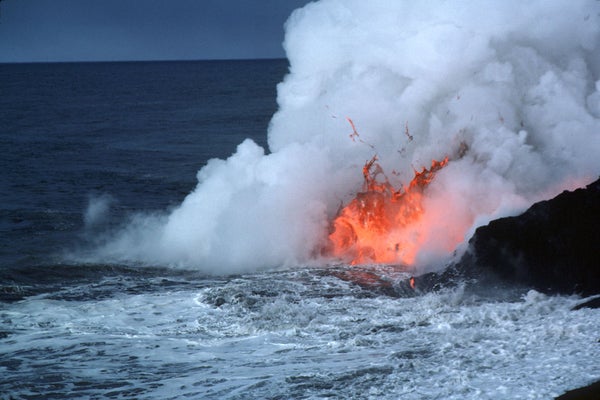This article was published in Scientific American’s former blog network and reflects the views of the author, not necessarily those of Scientific American
For a while, there, Kilauea settled into a predictable routine, and there wasn't much news surrounding the eruption. The most exciting and terrible thing was the lava channel developing a kink and the flow covering more structures and a park; otherwise, you could pretty much depend on the news being pretty much the same every day. But this past week has seen one quite dramatic event, plus a couple of awesome ones if you're a volcano geek.
First, the dramatic (and for some, traumatic) event: on July 16th, a lava tour boat skirted a little too near to the active ocean entry and got to see a littoral explosion up far too close. Passenger Will Bryan was filming when a lava bomb tore through the roof: you can't see much, but you can certainly hear what it would be like to be trapped while large chunks of molten rock rain down. One young woman suffered a broken femur, but happily, everyone survived. It could have gone very much worse.
Ikaika Marzo's boat was far enough away at the moment of the explosion to safely get some truly extraordinary footage:
On supporting science journalism
If you're enjoying this article, consider supporting our award-winning journalism by subscribing. By purchasing a subscription you are helping to ensure the future of impactful stories about the discoveries and ideas shaping our world today.
Look at the size of that blast! I haven't seen confirmation from the USGS yet, but the size of it makes me think a portion of the lava delta may have collapsed. I'll go over it in more depth in a future post, but briefly, here's what happens: when lava first enters the sea, it shatters and creates a rubbly platform of glassy volcanic rock bits. That mix of sand, gravel, and larger pieces becomes the foundation upon which the continuing lava flow builds a subaerial delta. But, as you can imagine, that's not a stable foundation at all! Lava is heavy, and waves are strong, and so the unconsolidated debris beneath shifts and erodes and eventually gives way, dumping a portion of the delta into the ocean.
Now, we're talking very hot rock here. There's stuff that has barely begun to solidify. There's stuff that's still merrily molten. There are lava tubes full of insulated lava that's nearly as piping hot as when it came out of the vent. Temperatures can reach 1,100°C (2,012°F for those of us who refuse to embrace the metric system) or higher. And now all that incandescent rock meets a lot of cold water, whose boiling point is a mere 100°C (212°F). The water flashes to steam. The steam causes a massive explosion. Rocks, still-molten lava, and steam go hurling in a most spectacular fashion, sometimes for hundreds of meters, and if a boat has skirted to close, you end up with bombs through the roof and a much more terrifying adventure than the lava tourists paid for.
We haven't even talked about the fact that your boat may be subsequently swamped by a wave of scalding-hot water, which thankfully did not happen here.
How can you avoid a similar fate but still get ultra-awesome photos and videos of the ocean entry? Take a tour on a boat that's staying at least 300 meters away. That's still risky, as debris can be scattered much further than that, but you should be out of the worst of it there.
There's a lot more explosive action that goes on at ocean entry points, some of which Kilauea has displayed in this very eruption, and I'm busy researching it for those of you who like all the details. I'm also looking in to this next neato and rather less explosive phenomenon: a wee bitty lava island has appeared!

A tiny wee babby island! Credit: USGS
The USGS says it appears to be a tumulus, which are not unusual at all. They're basically bulges caused by pressure from the slowly flowing lava. So we're not looking at the product of a new vent or volcano: it's just that the part of the existing flow that was moseying along the seabed swelled up and poked a bit of itself above the waves. This little island may build up and join the rest of the subaerial flow, or it might be eroded away if the flow wanes. It's just a delightful little bit of volcanic action that illustrates this feature beautifully.
The other neato thing that has emerged over the last week or so has been the connection between action at Kilauea's summit and the fountain at Fissure 8, which has been steadily pumping away for months now. Observers have noticed that when a portion of the summit crater collapses, which has been happening about once a day, the fountain becomes briefly invigorated a couple of hours later. It's the summit magma chamber that's feeding the eruption in the Lower East Rift Zone, so that's not actually surprising. It's just really fascinating to watch.
Kilauea is sure to come up with more surprises – USGS volcanologists say this eruption is pumping out lava at a much higher volume than the Pu'u O'o eruption that ran from 1983 until this year:
It's not more lava than the 1983-2018 Pu`u `O`o productivity (long way before we get to that point), but it certainly is "more quickly" -- it's put out about 5-6 years worth of Pu`u `O`o productivity in about 2 months.
And that, my friends, means this is definitely an eruption to keep watching!
